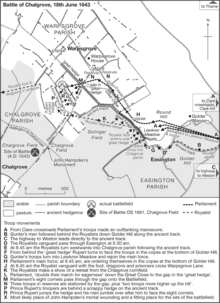Battle of Chalgrove Field
Hoping to capture a Parliamentarian convoy containing £21,000 in cash, during the night of 17 to 18 June Royalist cavalry from Oxford led by Prince Rupert raided positions around Chinnor.The Royalists focused on fortifying their wartime capital in Oxford and connecting key areas of support in England and Wales, while Parliament consolidated control of those they already held.[4] The Royalist war effort was hampered by shortage of weapons, since Parliament held the largest arsenals in England and controlled most of the major ports, making it difficult to import them.In February a large consignment of weapons purchased by Queen Henrietta Maria in the Dutch Republic landed in Bridlington, Yorkshire and preparations began to escort it to Oxford.They found the garrison waiting and retreated; as they did so, Scots mercenary Sir John Urry defected, bringing information on the London convoy and Essex's troop positions.[9] While three troops under Hampden and Major John Gunter maintained contact with the Royalists, the local commander at Thame, Sir Philip Stapleton, hastily pulled together a force to attack them.It also minimised his weaknesses, one being his cavalry's ill-discipline, which cost the Royalists victory at Edgehill, and led to defeat at Naseby; at Chalgrove, this was limited by their horses being exhausted after a night of hard riding.The damage to his reputation was sealed when Rupert's men spent the next day at Chalgrove distributing their loot, and preparing for a triumphal entry into Oxford, while the Parliamentarian army looked on.

First English Civil WarChalgroveOxfordshireRoyalistsParliamentariansPrince RupertLord WentworthWilliam LeggePhilip StapletonJohn HampdenColonel Dalbier1st HullMarshall's ElmPortsmouthPlymouthBabylon HillPowick BridgeKings NortonEdgehillAylesburyBrentfordTurnham GreenFarnham CastlePiercebridgeTadcaster1st ExeterMuster Green1st BradfordChichesterBraddock Down1st MiddlewichHopton HeathSeacroft MoorCamp HillLichfieldRipple FieldReadingSourton Down1st Wardour CastleStrattonWakefield1st WorcesterAdwalton Moor2nd BradfordBurton BridgeLansdowneRoundway Down1st BristolGainsboroughGloucester2nd HullAldbourne Chase1st NewburyWincebyOlney Bridge1st Basing HouseHeptonstall2nd Wardour CastleSouth HartingBramber BridgeArundel2nd MiddlewichNantwichNewcastle1st Lathom HouseNewarkBoldon HillStourbridge HeathCheritonLyme RegisLincoln1st OxfordBolton2nd Basing HouseTipton GreenOswestryCropredy BridgeMarston MoorGunnislake New BridgeOrmskirkLostwithielTippermuir1st AberdeenMontgomery Castle1st Chester1st TauntonCarlisle2nd NewburyInverlochyHigh Ercall HallWeymouthScarborough Castle2nd TauntonAuldearn3rd Taunton2nd OxfordNasebyAlford2nd Lathom HouseLangportHerefordKilsyth2nd BristolPhiliphaugh2nd ChesterRowton HeathSherburn in Elmet3rd Basing HouseAnnan MoorDenbigh GreenShelford HouseBovey HeathTorringtonStow-on-the-Wold3rd Oxford2nd AberdeenLagganmore2nd WorcesterParliamentarianRoyalistOxfordChinnorcapture of ReadingEarl of EssexParliamentpeace talks